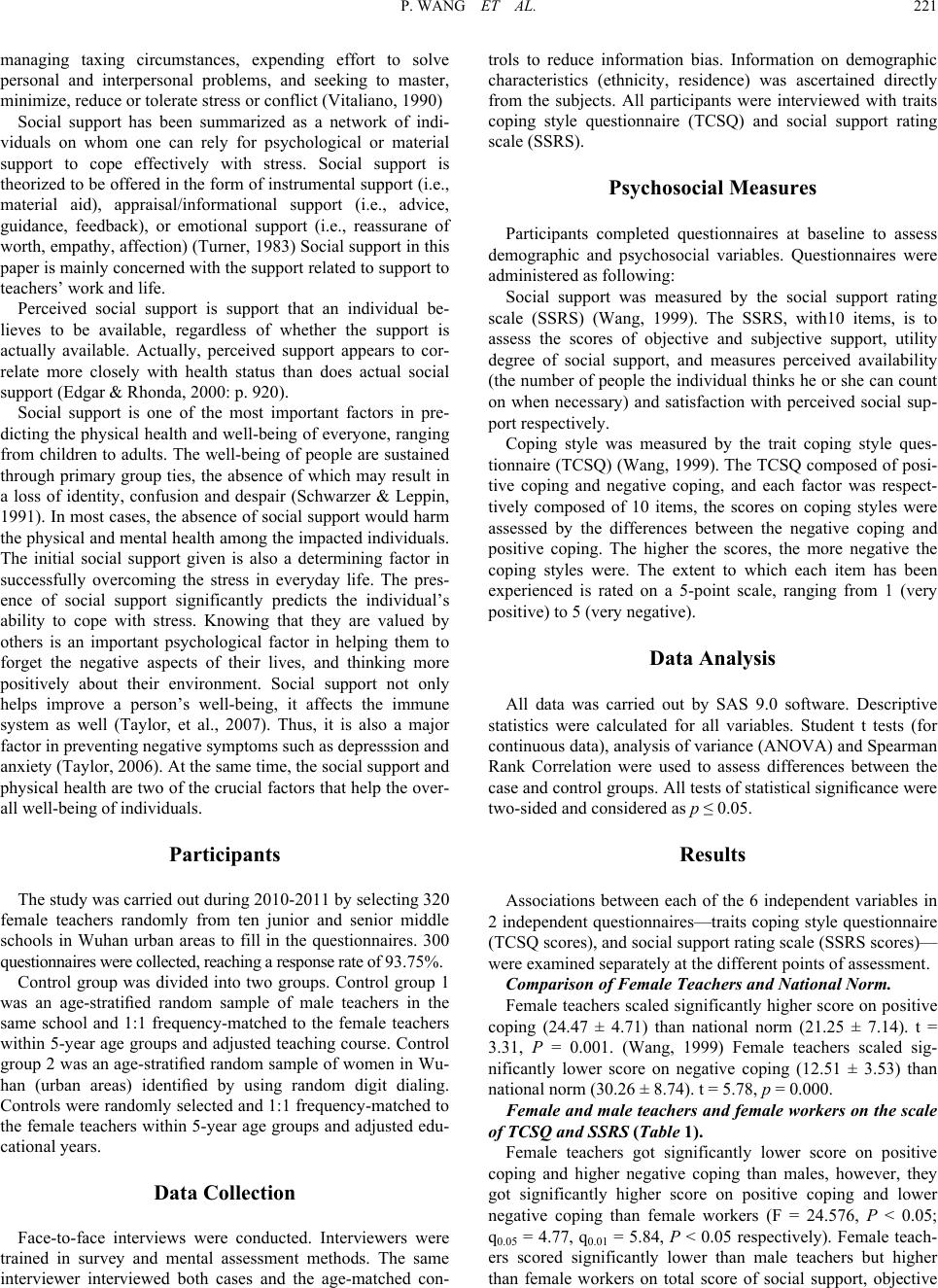
P. WANG ET AL. 221
managing taxing circumstances, expending effort to solve
personal and interpersonal problems, and seeking to master,
minimize, reduce or tolerate stress or conflict (Vitaliano, 1990)
Social support has been summarized as a network of indi-
viduals on whom one can rely for psychological or material
support to cope effectively with stress. Social support is
theorized to be offered in the form of instrumental support (i.e.,
material aid), appraisal/informational support (i.e., advice,
guidance, feedback), or emotional support (i.e., reassurane of
worth, empathy, affection) (Turner, 1983) Social support in this
paper is mainly concerned with the support related to support to
teachers’ work and life.
Perceived social support is support that an individual be-
lieves to be available, regardless of whether the support is
actually available. Actually, perceived support appears to cor-
relate more closely with health status than does actual social
support (Edgar & Rhonda, 2000: p. 920).
Social support is one of the most important factors in pre-
dicting the physical health and well-being of everyone, ranging
from children to adults. The well-being of people are sustained
through primary group ties, the absence of which may result in
a loss of identity, confusion and despair (Schwarzer & Leppin,
1991). In most cases, the absence of social support would harm
the physical and mental health among the impacted individuals.
The initial social support given is also a determining factor in
successfully overcoming the stress in everyday life. The pres-
ence of social support significantly predicts the individual’s
ability to cope with stress. Knowing that they are valued by
others is an important psychological factor in helping them to
forget the negative aspects of their lives, and thinking more
positively about their environment. Social support not only
helps improve a person’s well-being, it affects the immune
system as well (Taylor, et al., 2007). Thus, it is also a major
factor in preventing negative symptoms such as depresssion and
anxiety (Taylor, 2006). At the same time, the social support and
physical health are two of the crucial factors that help the over-
all well-being of individuals.
Participants
The study was carried out during 2010-2011 by selecting 320
female teachers randomly from ten junior and senior middle
schools in Wuhan urban areas to fill in the questionnaires. 300
questionnaires were collected, reaching a response rate of 93.75%.
Control group was divided into two groups. Control group 1
was an age-stratified random sample of male teachers in the
same school and 1:1 frequency-matched to the female teachers
within 5-year age groups and adjusted teaching course. Control
group 2 was an age-stratified random sample of women in Wu-
han (urban areas) identified by using random digit dialing.
Controls were randomly selected and 1:1 frequency-matched to
the female teachers within 5-year age groups and adjusted edu-
cational years.
Data Collection
Face-to-face interviews were conducted. Interviewers were
trained in survey and mental assessment methods. The same
interviewer interviewed both cases and the age-matched con-
trols to reduce information bias. Information on demographic
characteristics (ethnicity, residence) was ascertained directly
from the subjects. All participants were interviewed with traits
coping style questionnaire (TCSQ) and social support rating
scale (SSRS).
Psychosocial Measures
Participants completed questionnaires at baseline to assess
demographic and psychosocial variables. Questionnaires were
administered as following:
Social support was measured by the social support rating
scale (SSRS) (Wang, 1999). The SSRS, with10 items, is to
assess the scores of objective and subjective support, utility
degree of social support, and measures perceived availability
(the number of people the individual thinks he or she can count
on when necessary) and satisfaction with perceived social sup-
port respectively.
Coping style was measured by the trait coping style ques-
tionnaire (TCSQ) (Wang, 1999). The TCSQ composed of posi-
tive coping and negative coping, and each factor was respect-
tively composed of 10 items, the scores on coping styles were
assessed by the differences between the negative coping and
positive coping. The higher the scores, the more negative the
coping styles were. The extent to which each item has been
experienced is rated on a 5-point scale, ranging from 1 (very
positive) to 5 (very negative).
Data Analysis
All data was carried out by SAS 9.0 software. Descriptive
statistics were calculated for all variables. Student t tests (for
continuous data), analysis of variance (ANOVA) and Spearman
Rank Correlation were used to assess differences between the
case and control groups. All tests of statistical significance were
two-sided and considered as p ≤ 0.05.
Results
Associations between each of the 6 independent variables in
2 independent questionnaires—traits coping style questionnaire
(TCSQ scores), and social support rating scale (SSRS scores)—
were examined separately at the different points of assessment.
Comparison of Female Teachers and National Norm.
Female teachers scaled significantly higher score on positive
coping (24.47 ± 4.71) than national norm (21.25 ± 7.14). t =
3.31, P = 0.001. (Wang, 1999) Female teachers scaled sig-
nificantly lower score on negative coping (12.51 ± 3.53) than
national norm (30.26 ± 8.74). t = 5.78, p = 0.000.
Female and male teachers and female workers on the scale
of TCSQ and SSRS (Table 1).
Female teachers got significantly lower score on positive
coping and higher negative coping than males, however, they
got significantly higher score on positive coping and lower
negative coping than female workers (F = 24.576, P < 0.05;
q0.05 = 4.77, q0.01 = 5.84, P < 0.05 respectively). Female teach-
ers scored significantly lower than male teachers but higher
than female workers on total scoe of social support, objective r